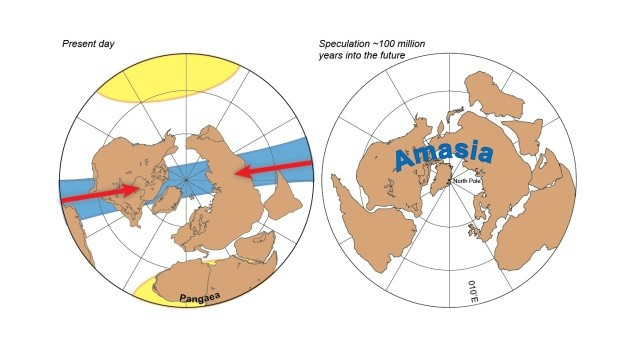New Supercontinent Amasia to Form Over the Arctic Ocean?

Scientists at Yale University have predicted the birth of an all-new supercontinent formed by the crashing of America and Eurasia into each other in the distant future. It is estimated that the Earth's existing continents will be absorbed into a single landmass around the North Pole, paving the way for Earth's magnetic plates' tectonic activity.
The theory behind this concept is popularly termed "continental drift", wherein the slow movements of the continents are expected to continue for the next tens of millions of years. The result of this process gives rise to areas such as the Mid-Atlantic Ridge, where Iceland has formed, and areas such as that off the coast of Japan, where one plate rides over another.
The shifting of the Earth's magnetic plates has given birth to hypothesised supercontinents of Nuna 1.8 billion years ago, Rodinia a billion years ago, and then Pangaea 300 million years ago. Pangaea was apparently formed with constant grouping of landmasses unified on the equator and centred in the region of West Africa.
A close observation at the geology of mountain ranges spread across the world, indicates that the the next supercontinent would arise either in the same place as Pangaea, closing the Atlantic Ocean like an accordion, or on the other side of the world, in the middle of the current Pacific Ocean.
However, Ross Mictchell and his team of geological scientists at Yale University in Haven Connecticut, propose a new theory altogether. Their analysis on magnetic plates of Earth and the formation of Earth's crust has deduced surprising revelations, wherein the next supercontinent - dubbed Amasia - should form 90 degrees away from Pangaea, over the Arctic.
"First you would fuse the Americas together, then those would mutually migrate northward leading to collision with Europe and Asia more or less at the present day North Pole," says Mitchell. He adds: "Australia would continue with northward motion and snuggle up next to India."
Mitchell and his colleagues propose that this is part of a pattern: Pangaea formed at about 90 degrees to the previous supercontinent, Rodinia, and Rodinia at about 90 degrees to Nuna, which existed around 2 billion years ago.
The scientists have named this model orthoversion, as opposed to introversion - in which the supercontinent forms where Pangaea was - or extroversion, in which it moves round to the other side of the world, staying on the equator.
Orthoversion helps solve a conundrum that has bothered geologists. They knew there had been supercontinents in the past, and that these land masses had a variety of configurations, "but we weren't quite sure whether there was method in the madness as you went from one to the other," says Peter Cawood, a geologist at St Andrews University, UK.
The way Earth's continents move has implications for biology - for example, it affects how easily species can mingle over time. "Understanding the disposition of continental masses is fundamental in our understanding of Earth's history," says Cawood. "Rocks are our windows onto history."
Enjoy the video depicting the continental drift and the theory behind the formation of new supercontinents:
Courtesy: Nature.com
Listen to this enthralling Nature Podcast, revealing secrets behind Nature's unanswered mysteries:
Courtesy: Nature.com
Must Read: iPad 3 Launch Imminent: Other Expected iDevices in Pipeline and iOS 5.1 Upgrade Tutorial
Must Read: iPad 3: Release Dates, Expected Features and What Not to Expect
© Copyright IBTimes 2025. All rights reserved.






















